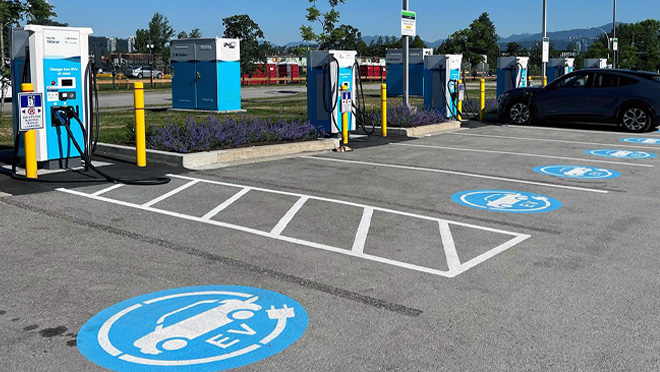In 2024, urban EV charging hubs are transforming city transportation by making electric vehicle (EV) ownership more convenient and sustainable. With over 10 million electric cars sold globally in 2023, according to Bloomberg Green, the demand for efficient charging solutions has never been higher. Urban areas, where space is limited and pollution concerns are pressing, are witnessing a revolution in how we power our vehicles. This article explores the innovative concept of urban EV charging hubs and how they are set to redefine city transport.
The Rise of Urban EV Charging Hubs
What Are Urban EV Charging Hubs?
Urban EV charging hubs are centralized locations equipped with multiple charging stations designed to serve a large number of electric vehicles simultaneously. These hubs are strategically placed in city centers, residential areas, and near public transport links to maximize accessibility. The concept is not just about providing a place to charge but creating an integrated ecosystem that supports fast, efficient, and sustainable mobility.
Why Are Charging Hubs Gaining Popularity?
- Convenience: With urban EV charging hubs, drivers can charge their vehicles while running errands, shopping, or commuting. This convenience is crucial as the global EV market is projected to reach 145 million vehicles by 2030 (IEA).
-
Efficiency: Charging hubs often feature fast chargers that can power an EV up to 80% in just 30 minutes, according to Electrek. This quick turnaround is essential for busy urban dwellers.
-
Sustainability: Many hubs incorporate solar panels and battery storage systems, reducing reliance on fossil fuels and lowering carbon footprints, as highlighted by PV Magazine.
Key Players and Innovations
-
Tesla’s Supercharger Network: Tesla continues to expand its Supercharger network in urban areas, with a focus on high-density regions like New York and London. Their V3 Superchargers can deliver up to 250 kW, dramatically reducing charging time.
-
Volkswagen’s Electrify America: With plans to install over 10,000 chargers by the end of 2024, Electrify America is focusing on urban hubs that offer charging speeds up to 350 kW.
-
BP Pulse: This company is transforming traditional petrol stations into EV charging hubs, providing a familiar location for drivers to recharge.
The Impact on Urban Mobility
Enhanced Accessibility
Urban EV charging hubs make electric vehicles more accessible by reducing the “range anxiety” many potential EV owners face. With strategically placed hubs, drivers can confidently navigate cities knowing a quick charge is always nearby.
Reduction in Air Pollution
Cities like Los Angeles and Beijing, notorious for their pollution levels, are seeing significant improvements in air quality as more EVs replace traditional combustion engines. According to Reuters Mobility, urban EV charging hubs are pivotal in supporting this shift, contributing to cleaner city air.
Economic Benefits
- Job Creation: The installation and maintenance of charging hubs create jobs in construction, technology, and services sectors.
-
Local Business Boost: By situating charging hubs near shopping areas or restaurants, local businesses benefit from increased foot traffic as drivers wait for their vehicles to charge.
Challenges and Solutions
Despite their benefits, urban EV charging hubs face challenges:
- Infrastructure Costs: Building these hubs requires significant investment. However, partnerships between governments and private companies, as seen with Hyundai’s commitment to expand charging infrastructure, are helping to mitigate costs.
-
Grid Capacity: As demand for electricity increases, so does the strain on the grid. Solutions include smart grid technology and energy storage systems that balance supply and demand.
Practical Tips for EV Owners
How to Use Urban EV Charging Hubs
-
Locate Nearby Hubs: Use apps like PlugShare or ChargePoint to find the nearest charging hub.
-
Check Availability: These apps also provide real-time information on charger availability to avoid waiting times.
-
Plan Your Charge: Consider your schedule and charge during less busy times, like mid-morning or late evening, to ensure quicker access.
What to Consider When Charging
-
Charging Speed: Not all chargers are created equal. Fast chargers are ideal for quick top-ups, while Level 2 chargers are suitable for longer parking durations.
-
Cost: Compare prices across different hubs. Some offer membership plans that reduce costs for frequent users.
Where to Buy an EV
With the rise of urban EV charging hubs, now is a great time to consider buying an electric vehicle. Brands like Nissan, Ford EV, and Rivian offer a range of models to suit different needs and budgets. Check out local dealerships or online platforms for the latest deals.
Conclusion
Urban EV charging hubs are revolutionizing city transport by making electric vehicles a viable option for more people. They enhance accessibility, reduce pollution, and provide economic benefits, all while supporting the global push towards sustainable living. As we look to the future, the continued expansion and innovation of these hubs will be crucial in shaping the cities of tomorrow.
What do you think about the rise of urban EV charging hubs? Share your thoughts in the comments below and join the conversation. As we move forward, the integration of technology and sustainability will only deepen, paving the way for a cleaner, greener urban environment.

